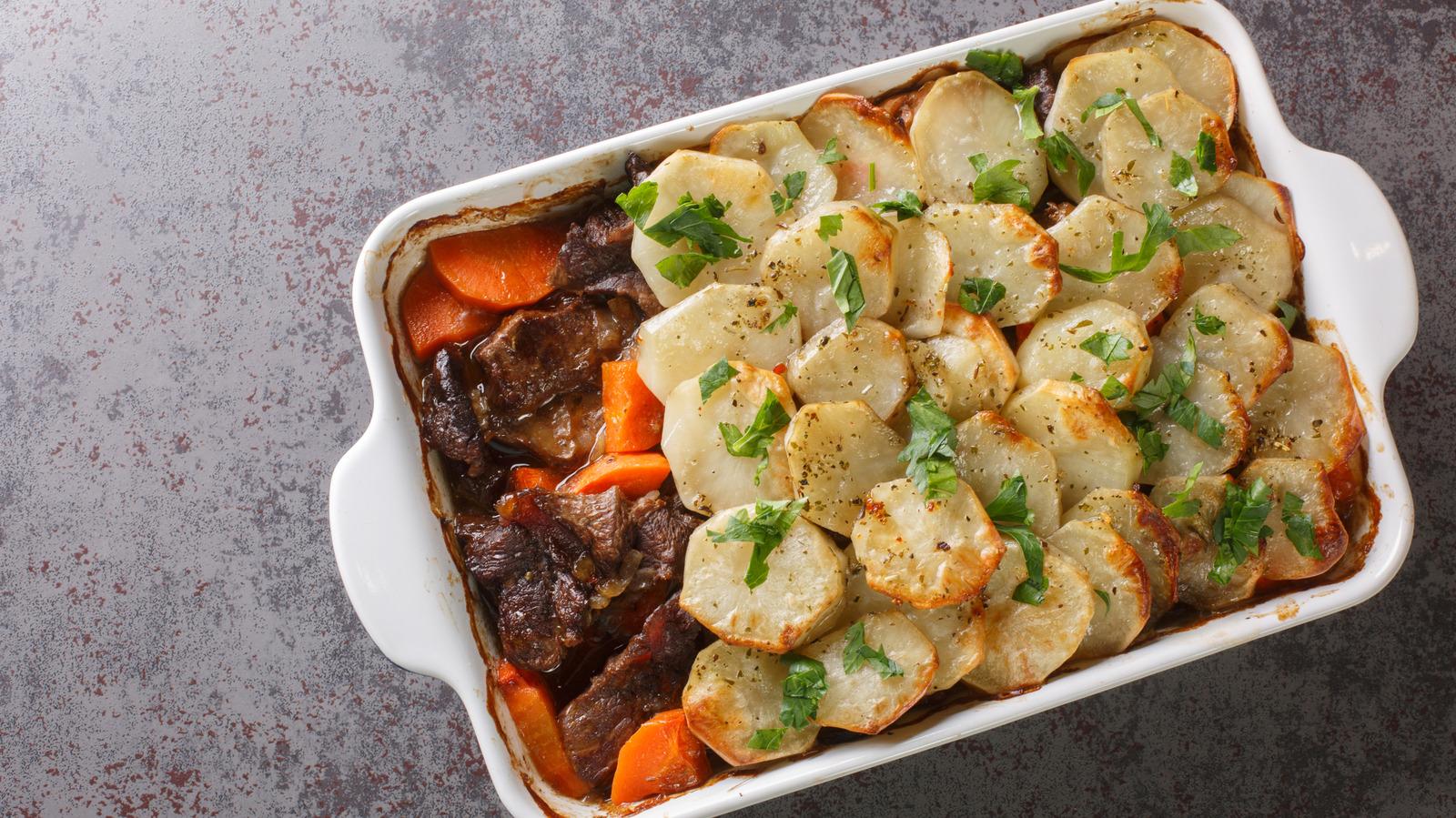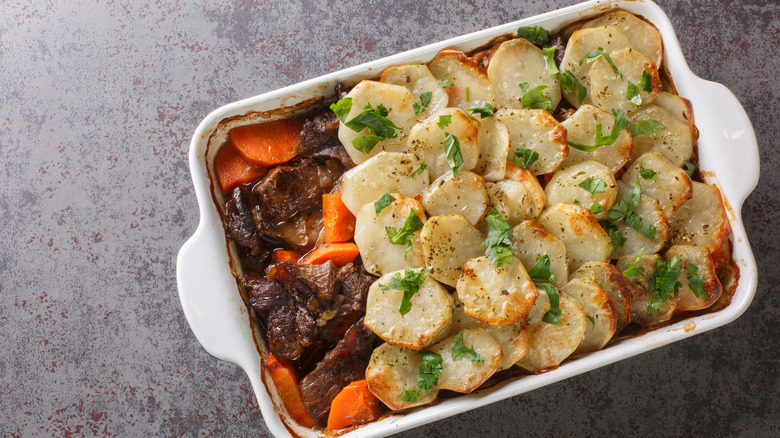
Alleko/Getty Images
British food doesn't always get the best press. It's often dismissed as stodgy or outdated, especially when compared to fresh Mediterranean recipes or trendy street food. But there's a whole catalogue of old-school British dishes that are quietly comforting and tastier than a lot of folks give them credit for. And these aren't just retro novelty dishes — they're foods that have been enjoyed for generations, often linking to regional identity and with a respect for simple ingredients.
There are some British dishes you need to try before you die, but what about the classics of the past? Some were once staples of working-class homes, kept alive by home cooks across the nation. Others graced Victorian tables and tearooms before fading into obscurity. Now, it might just be time to dust off these dishes and give them a second look.
Whether you're looking to try something new or just want to experience a well-cooked classic, these dishes deserve a spot back on our tables. All of them are still staples in some British homes, but are quickly falling out of favor with the popularity of world cuisine. We're all for trying different things, but let's not allow the classics to fall to the wayside. Here are some old-school British eats that are overdue for a comeback — and why you should care.
Lancashire butter pie

Jeremy Gable / 500px/Getty Images
A traditional Lancashire butter pie consists of a simple potato and onion filling, enriched with butter. The lack of meat is no accident, as it was originally made for Catholic workers in Lancashire who abstained from meat on Fridays. What you get is simple but hearty and comforting.
Thinly sliced potatoes are layered with onions and plenty of seasoning, then baked in a shortcrust or rough puff pastry case until tender inside and golden on top. The magic lies in how the butter melts into the veg as it bakes, creating a soft, almost confit-like texture. While potatoes have a simple flavor, the onion brings a lot to the party here.
Served hot or at room temperature, butter pie is comfort food at its finest — and yet it rarely shows up on modern menus outside of Lancashire. Luckily, it's easy enough to whip up at home. The most challenging part is making the pastry, and you can skip that step by using store-bought pastry dough if you aren't keen on spending too much time in the kitchen. You can also check out the mistakes everyone makes with homemade pie crusts to find out what you should avoid doing.
Teisen lap
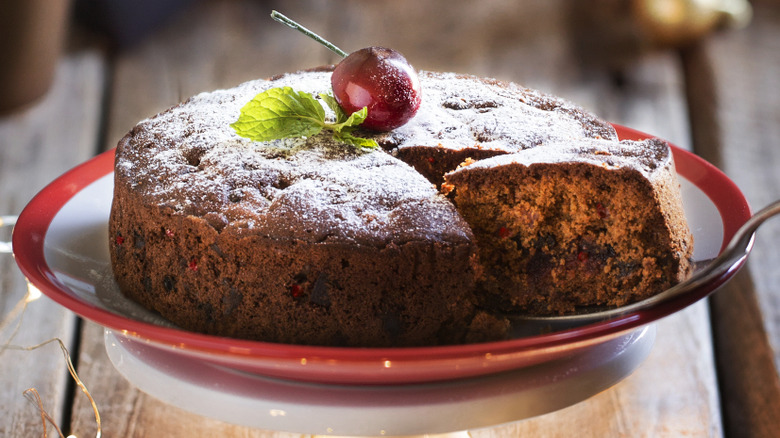
Twomeows/Getty Images
Teisen lap is a traditional cake from Wales, but it has fallen out of favor lately, particularly in other parts of the U.K. Its name means "moist cake," which might give you an idea of the texture. You might consider it a denser, squidgier version of a sponge cake.
Made with basic ingredients like flour, dried fruit, lard or butter, and sweet spices, teisen lap was originally popular in coal mining villages. It was often sent off with workers as a sweet in their lunch boxes, the moist texture meaning that it wouldn't crumble. Its gently spiced flavor and tender crumb make it perfect with a cup of tea, though it's surprisingly good warmed up with custard too.
What we love about this cake is its no-fuss approach. It's not overly sweet, and it doesn't rely on decoration or frills. It's the sort of cake you make because you have everything in the cupboard already. In an era of increasingly elaborate bakes, there's something appealing about that simplicity.
Pease pudding

Alleko/Getty Images
Pease pudding doesn't have the glamour of other side dishes, which might be part of why it's not so popular today. And just when you thought you'd got your head around the confusing British pudding course, here's one to throw a spanner in the works. It's not a dessert nor a steamed pudding, and it isn't baked like a Yorkshire pudding. Rather, it's made from yellow split peas cooked until soft and blended with a bit of butter and seasoning. It's like a rustic, unspiced dal, but British.
Traditionally served in the North East in sandwiches with ham, potentially in breads like stottie cakes or oven bottom muffins, pease pudding is a bit of a cultural icon of the past. The peas break down into a creamy paste that holds its own next to salty meats or crusty bread. It's hard to describe to the uninitiated but absolutely delicious.
But it's incredibly versatile. Use it as a spread, serve it warm as a side dish, or repurpose leftovers into a soup base. It's also naturally vegan, if you skip the traditional meat pairings, and rich in protein and fibre. That makes it a smart choice for modern diets, even if it comes wrapped in centuries of tradition. Give it a try next time you need something hearty on toast.
Potted shrimp
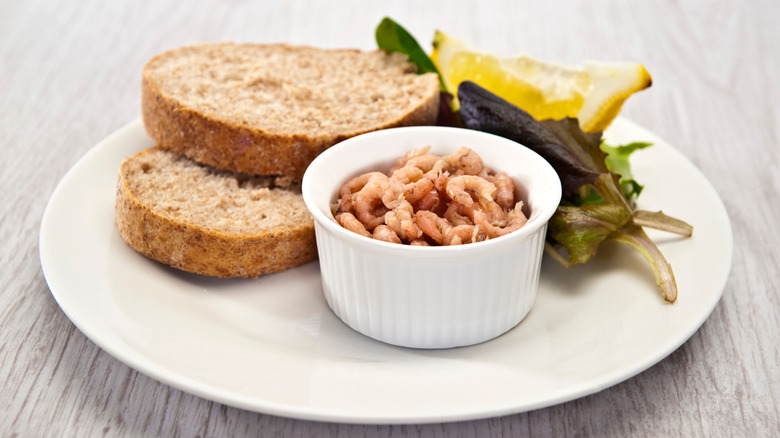
Markgillow/Getty Images
Potted shrimp might not look like much at first glance, but don't underestimate it. The dish basically consists of shrimp suspended in spiced butter. This is one of those rare old-school British dishes that's actually quite elegant. Maybe in a retro way, but that doesn't stop it from tasting great.
Typically made with Morecambe Bay brown shrimp, the method involves poaching the shrimp in browned butter with a touch of warm spice, then packing the mixture into ramekins or pots. Once chilled, the butter sets and preserves the shrimp. There are also some variations that involve clarifying the butter. Spread on toast, it's an indulgent snack with a vintage feel.
Potted shrimp fell out of fashion as tastes shifted toward fresher, more lightly dressed seafood, but it deserves another look. Not only is it a brilliant make-ahead appetizer, but it's also rooted in British food culture. Served with bread and lemon, it holds its own against other starters and small plates. If you're someone who likes anchovy butter or sardines on toast, potted shrimp might be to your taste. And it's surprisingly easy to make at home. So prepare yourself to have a new favorite.
Bedfordshire clanger
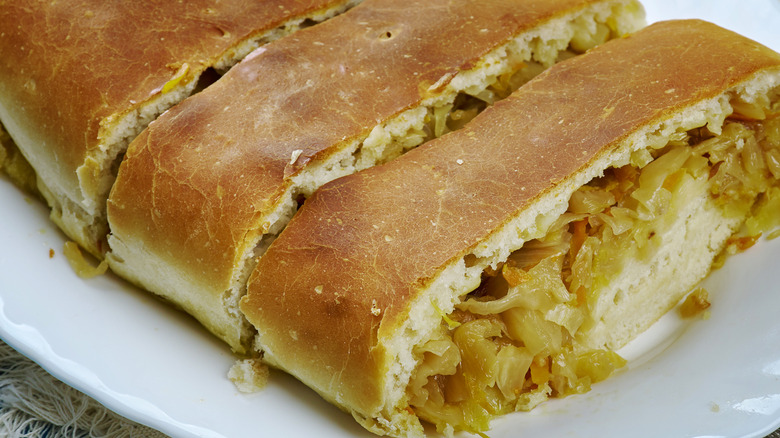
Chatham172/Shutterstock
Imagine a pastry with both your dinner and dessert inside — and you've got the Bedfordshire clanger. This two-in-one pastry, with meat at one end and fruit at the other, sounds like a gimmick, but it was pure practicality. For 19th century agricultural workers, it meant carrying one self-contained meal into the fields.
The traditional savory end might hold ham and potatoes or bacon and onion, while the sweet side could feature apple, jam, or dried fruit. All of it was wrapped in suet or shortcrust pastry and baked until golden. It's a bit like a Cornish pasty if half of it was sweet and half was savory. Sure, it's a strange dish but one that makes total sense in context.
Originating from the county of Bedfordshire, the clanger deserves another look — not just for novelty value, but because it works. Whether you're packing lunch for a hike or just a Tuesday in the office, it's a fun, self-contained option. And if you're feeding a crowd, it's a brilliant conversation starter, too. Who said that lunch had to be serious?
Spotted dick
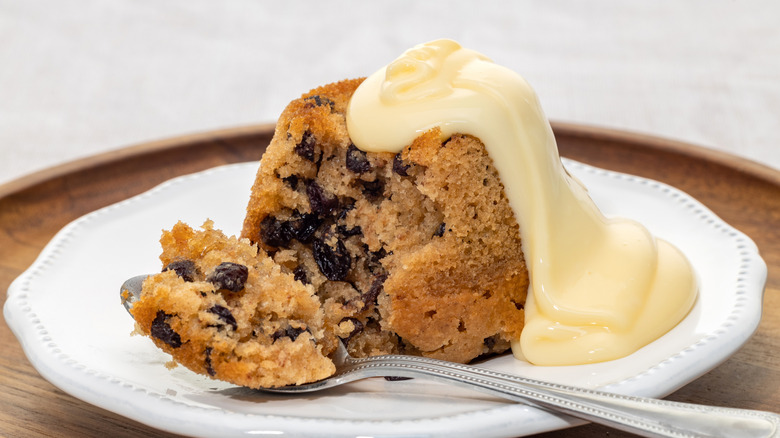
Clubfoto/Getty Images
The name might raise eyebrows, but the pudding itself is a fine example of British comfort food. Spotted dick is a steamed suet dessert stirred through with dried fruit — those are the "spots" — and generally served warm with custard. It's not as popular any more, losing out to richer, flashier desserts, but we think it's worth another chance.
Suet puddings like this one were once the backbone of British desserts. The suet gives the pudding a tender, almost spongy crumb, and the dried fruit (usually currants or raisins) adds texture and extra sweetness without using too much sugar in the dough.
Spotted dick is old-fashioned in the best way. It doesn't rely on complicated technique, just good ingredients and proper steaming. Yes, it takes time, but the payoff is real to beat.
With the rise of plant-based cooking, you can even make vegan and vegetarian versions using vegetable suet or frozen grated margarine. Either way, don't skimp on the custard — it's part of the experience. If you're nostalgic for school puddings or curious about traditional British sweets beyond scones and Victoria sponge, this one's worth reviving. Find yourself a good spotted dick recipe and give it a try.
Rumbledethumps

Fanfo/Shutterstock
Rumbledethumps is the Scottish dish that makes excellent use of leftovers. It combines mashed potatoes, cabbage, and onion into a bake that's greater than the sum of its parts. It's designed to be made with leftovers — all of these ingredients would once have been everyday eats at various points in history — but you can cook the separate ingredients from scratch if you want to.
You start with mashed potatoes and fold in sautéed shredded cabbage and cooked onions. Season well, transfer to a shallow dish, sprinkle with extra cheese or breadcrumbs if you like, and bake until the top gets a golden crust. The resulting dish is a delicious side that's so much more flavorful than plain mashed potatoes, but plays the same role. It's similar to bubble and squeak, but being baked and topped with cheese gives it a different vibe.
We love turning scraps into something delicious, so this is a perfect dish. Cooked cabbage and plain mash suddenly become a hearty, flavorful side. Rumbledethumps is forgiving, too. You can swap in kale if cabbage isn't your thing, or mix in leftover leeks, chard, or sprouts. Most leafy greens and alliums will do the trick, even if it makes the finished dish slightly different. We also love that it takes minutes to prep, if you have leftovers to work with. The oven does all the heavy lifting. In a time when reducing waste and cooking simply are more appealing than ever, rumbledethumps checks both boxes.
Dock pudding
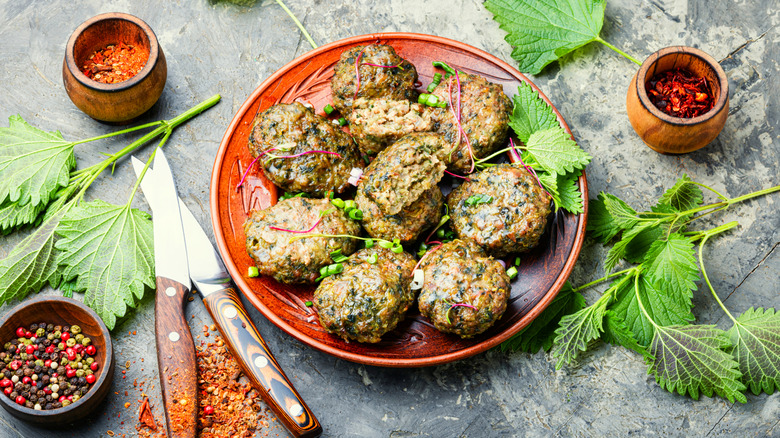
Mykolal Mykolal/Shutterstock
If you like the idea of foraging food, dock pudding should be on your radar. It's made from foraged bistort, also called gentle dock. A Yorkshire specialty, particularly in the region of Calderdale, it mixes chopped gentle dock with spring onions, young nettles, oats, and seasoning, then cooks until rich and earthy.
Dock pudding has a rustic texture somewhere between stuffing and porridge. The oats bind everything together, and the wild greens add plenty of flavor. Depending on the recipe, it can be simmered or fried. It's likely that there are hyperlocal variations and differences between family recipes.
It's highly seasonal, as bistort emerges in early spring, so it's not something you'll find year round. If foraging isn't your thing, you can make a substitute version with spinach. It's not quite the same, but it will give you an idea of what it should be like. Once you've tried it, you'll understand why people in Calderdale still hold annual cook-offs to see whose version reigns supreme.
Singing hinnies

Jennifer A Smith/Getty Images
These griddle-cooked Northumbrian sweet treats get their name from the sound they make in the pan. Singing hinnies are a bit like dense scones but with a more flaky, crumbly texture. They're dotted with currants, enriched with both butter and lard, and cooked like a pancake until crisp outside and tender inside.
The dough is straightforward: flour, raising agent, sugar, dried fruit, fat, and just enough milk to bring it together. No proofing, no oven; instead, a heavy skillet over medium flame. Flip once, and you've got a treat that's perfect split and spread with butter, jam, or even a slice of cheddar. If you're a fan of griddle cakes, you need to try this British version.
They're surprisingly versatile. You can eat them warm for breakfast, serve them with clotted cream and jam like English scones, or slice and toast leftovers. If you swap lard for more butter, you've got a vegetarian snack that's ready in under 20 minutes. For a taste of Northeast England without the airfare, you can easily whip up a batch at home.
Laverbread and lavercakes
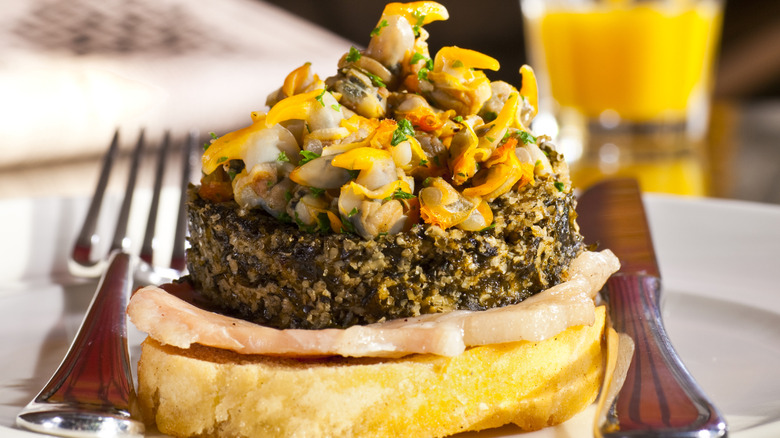
Huw Jones/Getty Images
Despite what you might expect from the name, this isn't any kind of bread. Perhaps one of the most underrated British foods, laverbread is a Welsh seaweed speciality that's often served on toast at breakfast. If you can find fresh Welsh laver seaweed, you can cook it yourself. However, since it needs around six hours of simmering, it's often bought already cooked and canned.
Laverbread is also commonly used to make lavercakes. To make them, start with cooked or tinned laverbread, mix with oatmeal and flour, shape into patties, and pan-fry until crisp. The result is a patty with a briny, umami depth reminiscent of anchovies or mushrooms. It's traditionally served with bacon or cockles, but you can skip the meat and still have a tasty meal. It's great served with fried mushrooms or eggs any way you like them.
Seaweed is underrated. Nutritionally, it's great for you — packed with iodine, minerals, and fibre. But it's also plain delicious. If you've never ventured beyond seaweed snacks, this is a must-try. The flavors will change how you think about greens.
Maids of honor

MShev/Shutterstock
Maids of honor go way back in British food history but are seen surprisingly rarely, even in the U.K. These tiny tarts date back to the Tudor era and have a pleasantly tangy filling made from fresh curd cheese (somewhere between cream cheese and ricotta) sweetened and baked in crisp pastry shells. They sometimes feature jam or lemon curd or extra sweetness and flavor.
The pastry is sturdy enough to hold its shape but has a melt-in-the-mouth quality, while the filling remains silky and just sweet enough to pair beautifully with tea or dessert wine. You don't need any fancy equipment to make them, either.
Maids of Honour sit somewhere between a Bakewell and a cheesecake, but lighter and more forgiving. They're perfect for parties — make a batch, freeze extras, and bake off as needed. It's rare to find sweet treats from this era that still match modern sensibilities. For instance, Tudor-era cakes are almost unrecognizable. But these feel oddly modern for something so old. That's why they absolutely need to make a comeback.
Lancashire hotpot
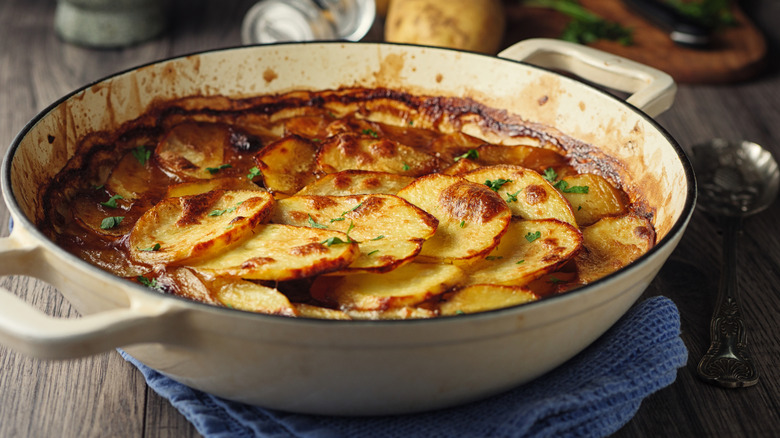
Haoliang/Getty Images
Lancashire hotpot isn't flashy, but that's part of its charm. This slow-cooked, one-pot classic from the Northwest is built on simple ingredients. It's a little bit like shepherd's pie but with its own take on proceedings. While it's not the most popular of dishes, especially outside of Britain, it deserves a place in the collection of hearty classics.
It consists of chunks of lamb or mutton, kidneys, onion, and carrots, cooked in a gravy, topped with an overlapping layer of sliced potatoes. Its seasonings are simple — just some bay leaves and a dash of Worcestershire sauce — but that's all you need to make this kind of simple dish. You can also easily make a vegetarian take on this dish with beans or mock meats.
It all goes into a deep dish and bakes low and slow. Keep it covered for most of its time in the oven so everything cooks through, then uncover it towards the end to let the potatoes crisp and turn golden on top. There's nothing complicated about hotpot, but it does take time. It's honest food that you might find yourself coming back to again and again. Serve it steaming hot with something like pickled red cabbage or mustardy greens on the side, and you've got a standout dinner.
Manchester pudding
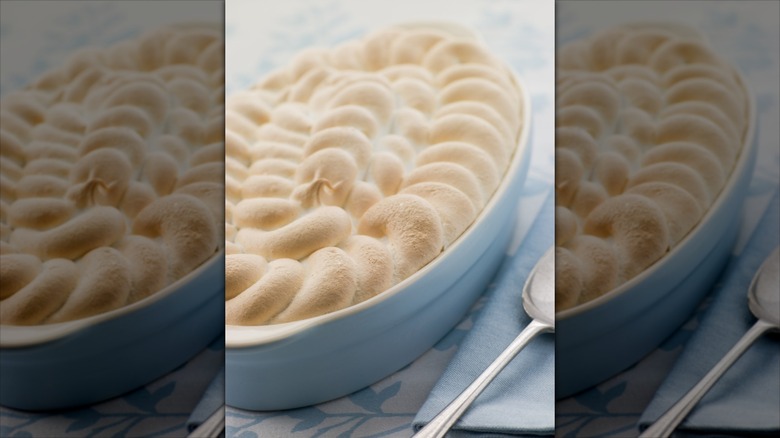
Monkey Business Images/Shutterstock
Also known as Queen of Puddings, this custardy bake has old-fashioned charm in spades. It may date as far back as the 1600s and was popular in the Victorian era, as a favorite of Queen Victoria. But today, it's not a common sight, perhaps because it's a little fussy to make. But that shouldn't stop you from experiencing its deliciousness.
It's built in three layers. The base is a mix of breadcrumbs stirred into a custard made from milk, sugar, and egg yolks. A layer of jam goes on next; raspberry is traditional, but blackcurrant or plum works beautifully, too. Finally, it's topped with meringue made from the leftover egg whites from the custard, beaten until glossy and stiff, then spooned or piped over the top and baked again until golden.
What makes this dish so special is the way the layers contrast and complement each other. You get the richness of the custard, the brightness of the jam cutting through, and the light sweetness of meringue in each mouthful. We don't know why it's stopped being popular, but it's in desperate need of a return.



